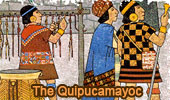The Quipucamayocs
Quipucamayocs, the accountants of the Inca Empire (called Tahuantinsuyu in old spelling Quechua) created and deciphered the quipu knots. Quipucamayocs were capable of performing simple mathematical calculations such as adding, subtracting, multiplying, and dividing information for the indigenous people.
They kept track of mita, a form of taxation. The Quipucamayocs also tracked the type of labor being performed, maintained a record of economic output, and ran a census that counted everyone from infants to "old blind men over 80". The system was also used to keep track of the calendar.
Quipucamayocs were from a class of people, "males, fifty to sixty", and were not the only members of Inca society to use the quipu. Inca historians used the quipu when telling the Spanish about Tahuantinsuyu history (whether they only recorded important numbers or actually contained the story itself is unknown). Members of the ruling class were usually taught to read the quipu in the Inca equivalent of a university, the yacha-huasi (literally, "house of teaching"), in the third year of schooling, for the higher classes who would eventually become the bureaucracy
Source:
Wikipedia: Quipucamayocs.
In the absence of written records the quipus served as a means of recording history and passed on to the next generation, which used them as reminders of stories. An thus these primitive computers - quipus
- had knotted in their memory banks the information which tied together the Inca
empire.

|